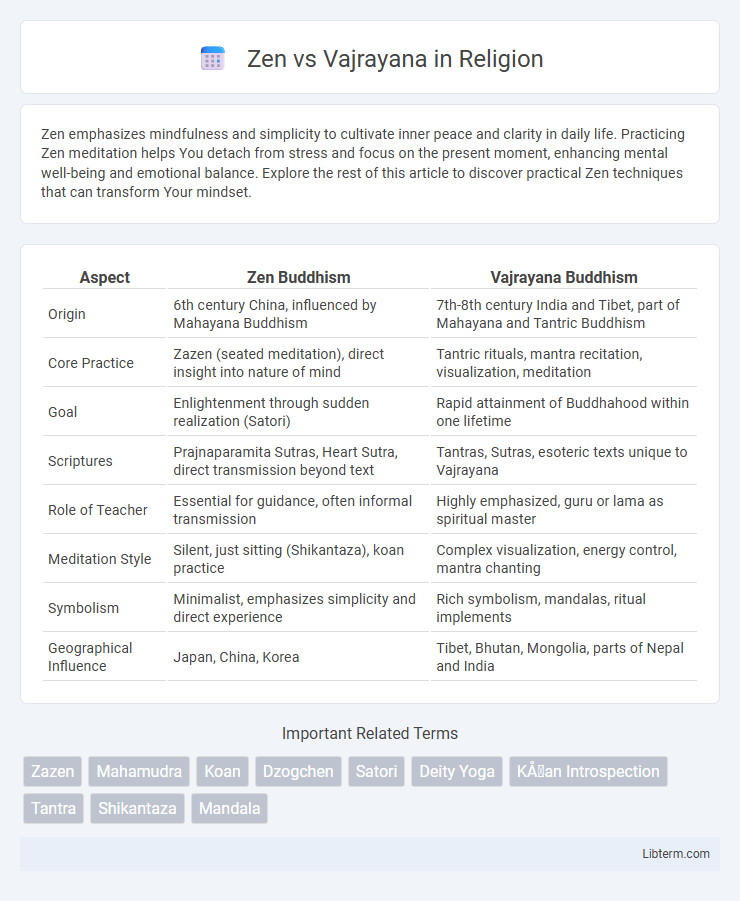Zen emphasizes mindfulness and simplicity to cultivate inner peace and clarity in daily life. Practicing Zen meditation helps You detach from stress and focus on the present moment, enhancing mental well-being and emotional balance. Explore the rest of this article to discover practical Zen techniques that can transform Your mindset.
Table of Comparison
| Aspect | Zen Buddhism | Vajrayana Buddhism |
|---|---|---|
| Origin | 6th century China, influenced by Mahayana Buddhism | 7th-8th century India and Tibet, part of Mahayana and Tantric Buddhism |
| Core Practice | Zazen (seated meditation), direct insight into nature of mind | Tantric rituals, mantra recitation, visualization, meditation |
| Goal | Enlightenment through sudden realization (Satori) | Rapid attainment of Buddhahood within one lifetime |
| Scriptures | Prajnaparamita Sutras, Heart Sutra, direct transmission beyond text | Tantras, Sutras, esoteric texts unique to Vajrayana |
| Role of Teacher | Essential for guidance, often informal transmission | Highly emphasized, guru or lama as spiritual master |
| Meditation Style | Silent, just sitting (Shikantaza), koan practice | Complex visualization, energy control, mantra chanting |
| Symbolism | Minimalist, emphasizes simplicity and direct experience | Rich symbolism, mandalas, ritual implements |
| Geographical Influence | Japan, China, Korea | Tibet, Bhutan, Mongolia, parts of Nepal and India |
Introduction to Zen and Vajrayana
Zen, a prominent school of Mahayana Buddhism, emphasizes direct experience and meditation (zazen) to achieve enlightenment, rooted in simplicity and mindfulness. Vajrayana, also known as Tantric Buddhism, incorporates esoteric rituals, mantras, and visualization techniques aimed at rapid spiritual transformation. Both traditions share foundational Buddhist teachings but differ significantly in practice and doctrinal focus.
Historical Origins and Development
Zen Buddhism originated in China during the Tang dynasty as Chan, integrating Indian Mahayana teachings with Chinese Daoist philosophy and emphasizing meditation (zazen) and direct insight. Vajrayana Buddhism evolved primarily in India and Tibet, emerging around the 7th century as an esoteric form of Mahayana that incorporates tantric rituals, mantras, and mandalas aimed at rapid enlightenment. While Zen centers on simplicity and intuitive understanding, Vajrayana developed complex ritualistic practices and initiations to transform the practitioner's body and mind.
Core Philosophical Foundations
Zen emphasizes direct experience and meditation (zazen) to realize the inherent Buddha-nature within, rooted in Mahayana teachings on emptiness (sunyata) and non-duality. Vajrayana incorporates tantric practices, including mantra, visualization, and ritual, aiming for rapid enlightenment by transforming ordinary experience through the union of wisdom and method. Both share Mahayana's emphasis on compassion (karuna) and emptiness but differ in methodology and symbolic complexity.
Meditation Techniques: Zazen vs. Vajrayana Practices
Zen meditation centers on Zazen, a practice involving seated meditation with focused attention on breath and posture to cultivate mindfulness and insight. Vajrayana meditation incorporates complex techniques such as visualization, mantra chanting, and ritualized movements, aiming to transform the practitioner's mind through symbolic and esoteric methods. These distinct approaches reflect Zen's emphasis on simplicity and direct experience versus Vajrayana's use of elaborate rituals and tantric practices to accelerate spiritual awakening.
Rituals and Symbolism
Zen Buddhism emphasizes minimalistic rituals and symbolism, prioritizing direct meditation practice (zazen) and silent mindfulness to achieve enlightenment. Vajrayana Buddhism incorporates elaborate rituals, intricate mudras, mantras, and mandalas, utilizing symbolic elements to guide practitioners through tantric practices toward rapid spiritual realization. The ritual complexity in Vajrayana contrasts with Zen's simplicity, reflecting divergent approaches to conveying profound Buddhist teachings.
The Role of Teachers and Lineage
Zen emphasizes direct transmission of insight from teacher to student through personal interaction and meditation practice, often highlighting the soto and rinzai lineages for preserving authentic teachings. Vajrayana relies heavily on a structured guru-disciple relationship where the lineage, rooted in tantric initiations and empowerments, ensures the transmission of esoteric knowledge and practices. Both traditions regard the teacher as essential, but Vajrayana's lineage incorporates ritual empowerment and complex symbolic transmission, whereas Zen prioritizes spontaneous realization guided by the master's presence.
Attitudes Toward Enlightenment
Zen emphasizes sudden insight and direct experience of enlightenment, often rejecting theoretical knowledge and ritualistic practices. Vajrayana adopts a more structured approach, integrating elaborate rituals, mantras, and visualization techniques to accelerate the path to enlightenment. Both traditions aim for ultimate awakening but differ fundamentally in methods and the perceived role of effort and practice.
Daily Practices and Discipline
Zen emphasizes zazen, or seated meditation, as its core daily practice, fostering mindfulness and direct experiential insight through silent, focused awareness. Vajrayana incorporates intricate rituals, mantra recitation, visualization techniques, and guru devotion, requiring disciplined adherence to esoteric practices aimed at rapid spiritual transformation. Both traditions demand consistent daily discipline, but Zen focuses on simplicity and direct presence, while Vajrayana embraces symbolic complexity and tantric methods.
Geographic Spread and Cultural Influence
Zen Buddhism, originating in China and flourishing primarily in Japan, emphasizes simplicity and meditation practices, deeply influencing East Asian cultures, particularly in Japan, Korea, and Vietnam. Vajrayana Buddhism, rooted in Tibet and Nepal, integrates complex rituals and tantric practices and has a significant cultural impact on Himalayan regions, including Bhutan and Ladakh. Both traditions have extended their geographic reach globally, with modern diasporas and Western interest fostering new cultural intersections.
Key Differences and Similarities
Zen and Vajrayana are both branches of Mahayana Buddhism but differ significantly in practice and philosophy; Zen emphasizes meditation (zazen) and direct insight into the nature of mind, while Vajrayana incorporates complex rituals, mantras, and visualization techniques aimed at rapid enlightenment. Both traditions share fundamental Buddhist concepts such as the Four Noble Truths and the goal of achieving enlightenment, but Vajrayana includes esoteric rituals that are absent in the minimalist, experience-focused Zen approach. Despite these differences, both paths stress the importance of a teacher-student relationship and the transformation of ordinary experience into spiritual awakening.
Zen Infographic

 libterm.com
libterm.com